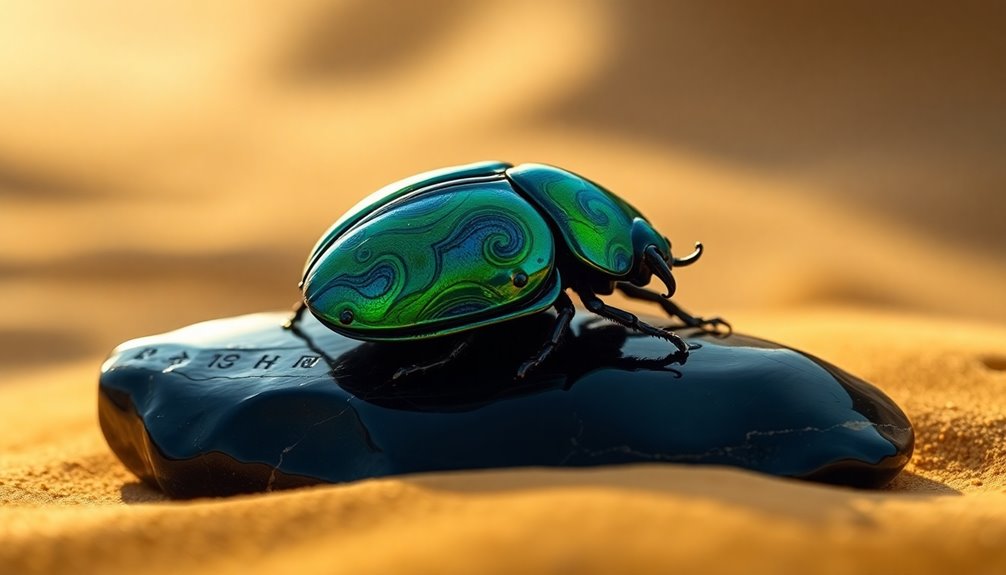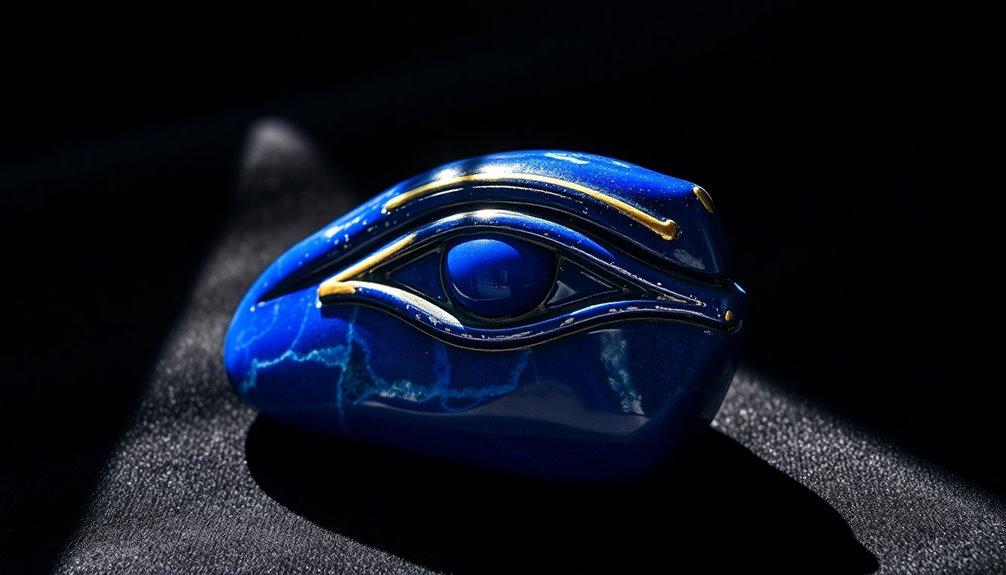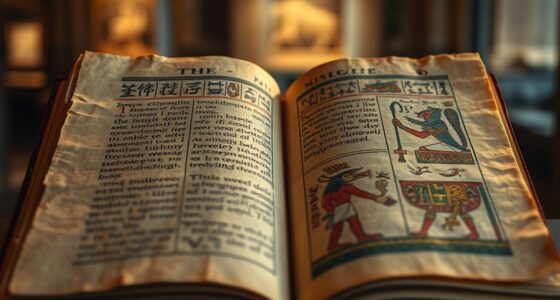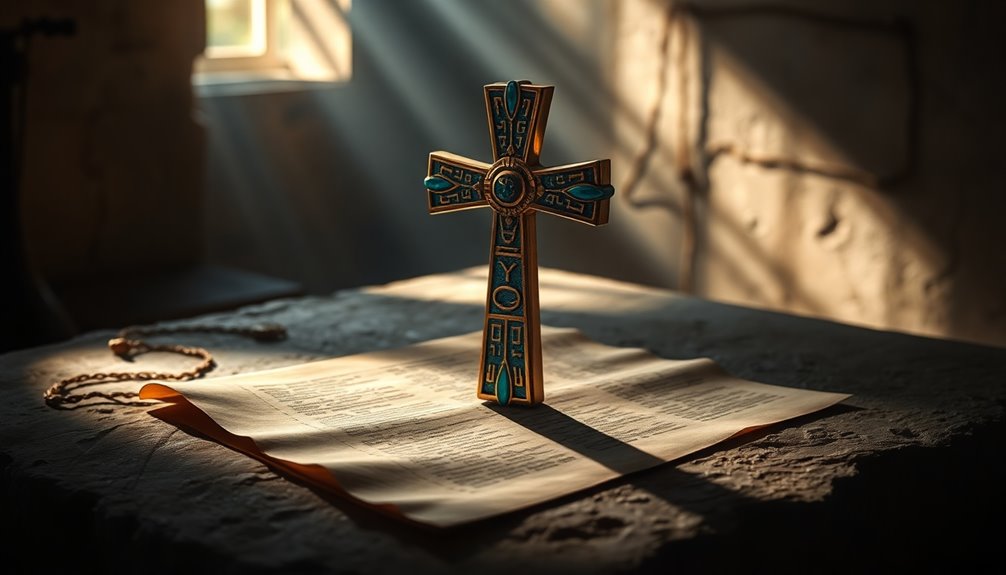The Egyptian Eye, mainly the Eye of Horus, symbolizes healing, protection, and justice, stemming from the myth of Horus's battle with his uncle Set. After losing his eye, Horus received restoration from the gods, making it a powerful emblem of regeneration and completeness. Each part of the eye represents different senses, reinforcing the connection of perception with divinity. Often depicted in art and used as amulets, this symbol aimed to ward off evil and guarantee health. The Eye of Ra contrasts sharply as a symbol of destruction. There's so much more behind this fascinating history that you might want to explore.
Key Takeaways
- The Eye of Horus symbolizes protection, healing, and restoration, originating from the myth of Horus's battle with Set and the recovery of his lost eye.
- Each part of the Eye of Horus represents different fractions, totaling 63/64, symbolizing completeness, imperfection, and connection to the five senses.
- Amulets featuring the Eye of Horus were believed to ward off evil and promote health, reflecting its cultural significance in ancient Egyptian spirituality.
- The Eye of Ra represents destruction and punishment, illustrating the duality of creation and chaos in Egyptian mythology alongside the Eye of Horus.
- Today, the Eye of Horus persists in modern culture as a symbol of protection, frequently seen in jewelry, tattoos, and contemporary art.
The Origin of the Egyptian Eye
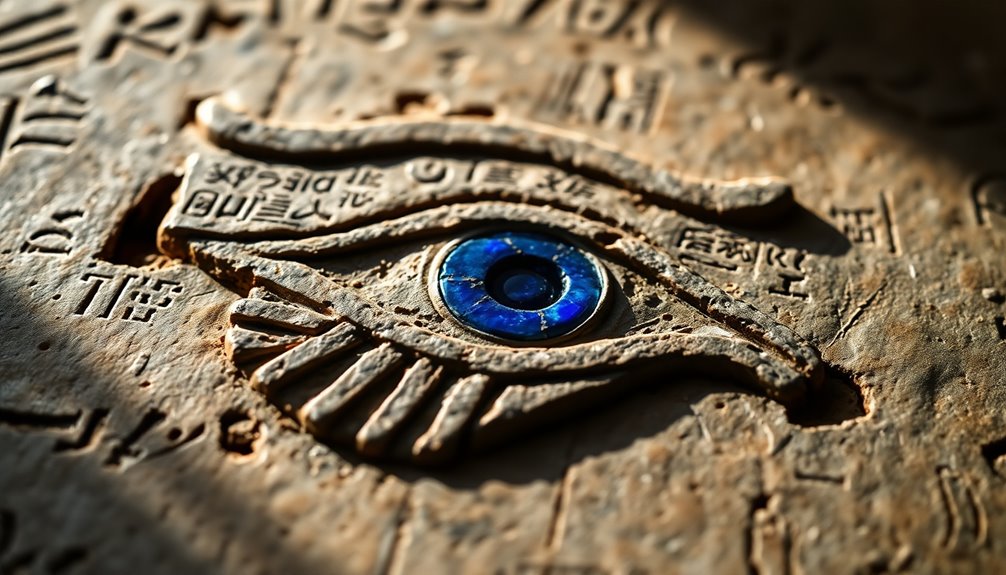
The Eye of Horus, a powerful symbol in ancient Egyptian mythology, has a fascinating origin rooted in the tales of protection and restoration. This emblem represents the falcon god Horus, who lost one of his eyes during a fierce battle with his uncle Set. The loss was significant, but what truly matters is how it was restored by the gods Hathor or Thoth, embodying concepts of healing and renewal.
The Eye of Horus is composed of six distinct parts, each reflecting the ancient Egyptians' keen understanding of mathematics and their belief in the eye's protective properties. Over time, this symbol evolved from a mere representation of goodness to a potent protective symbol, utilized in various aspects of daily life.
You might find it adorning jewelry, serving in medicinal practices, or gracing funerary artifacts. Its presence in tombs and sarcophagi underscores the Eye's crucial role in ancient Egyptian culture, emphasizing its connection to divine authority.
Horus and Set: A Tale of Betrayal
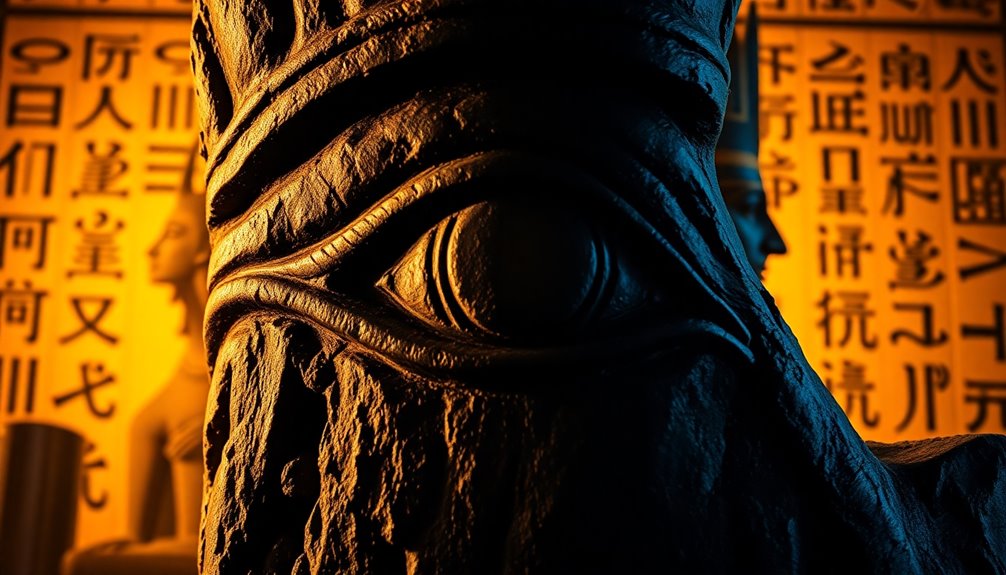
In the story of Horus and Set, you witness a gripping tale of betrayal that begins with the murder of Osiris by his brother Set.
As Osiris's wife, Isis, revives him, their son Horus rises to seek vengeance against Set, igniting a fierce conflict.
This struggle not only shapes their destinies but also symbolizes the eternal battle between order and chaos in ancient Egyptian mythology.
Osiris's Murder and Resurrection
Osiris's murder by his brother Set marks a pivotal moment in Egyptian mythology, setting off a chain of events that intertwines themes of betrayal, vengeance, and resurrection. Set, driven by ambition, sought the throne of Egypt, eliminating Osiris in a cruel act of treachery. This brutal murder left a void that would lead to further conflict.
In the wake of Osiris's death, his devoted wife, Isis, refused to accept his fate. Using her powerful magic, she temporarily revived him, which resulted in her becoming pregnant with their son, Horus. This child would grow up with a singular purpose: to avenge his father's murder.
The conflict between Horus and Set is marked by fierce battles, each one a demonstration of Horus's determination to reclaim his rightful place and honor his father. During these struggles, Horus lost one of his eyes, a symbol of the sacrifices made in his quest for vengeance.
However, the gods, recognizing his resilience, restored his eye, signifying healing and the importance of resurrection in their world. Ultimately, the saga of Osiris, Horus, and Set continues to resonate within the fabric of Egyptian mythology.
Horus's Vengeance Against Set
Horus sought fierce vengeance against Set, driven by the need to right the wrongs inflicted upon his family. After Set brutally murdered Osiris, Horus couldn't stand idly by. He engaged in a series of fierce battles, determined to reclaim not only his father's legacy but also the throne of Egypt.
This quest for justice came at a high cost; during the conflict, Horus lost one of his eyes. This loss symbolizes the sacrifices made in the pursuit of vengeance and restoration.
Different versions of the myth explain how Horus lost his eye. Some say it was damaged in battle, while others point to Set's treachery as the cause. Regardless, the eye's eventual restoration becomes a pivotal moment in the narrative, often attributed to the healing powers of the goddess Hathor or the god Thoth.
This act of healing wasn't just about regaining a physical attribute; it represented Horus's journey to justice and reestablishing order in the Egyptian pantheon.
Ultimately, Horus's triumph over Set avenged Osiris's death and reinstated rightful justice, solidifying his role as a protector of balance in the world.
The Symbolism of Healing
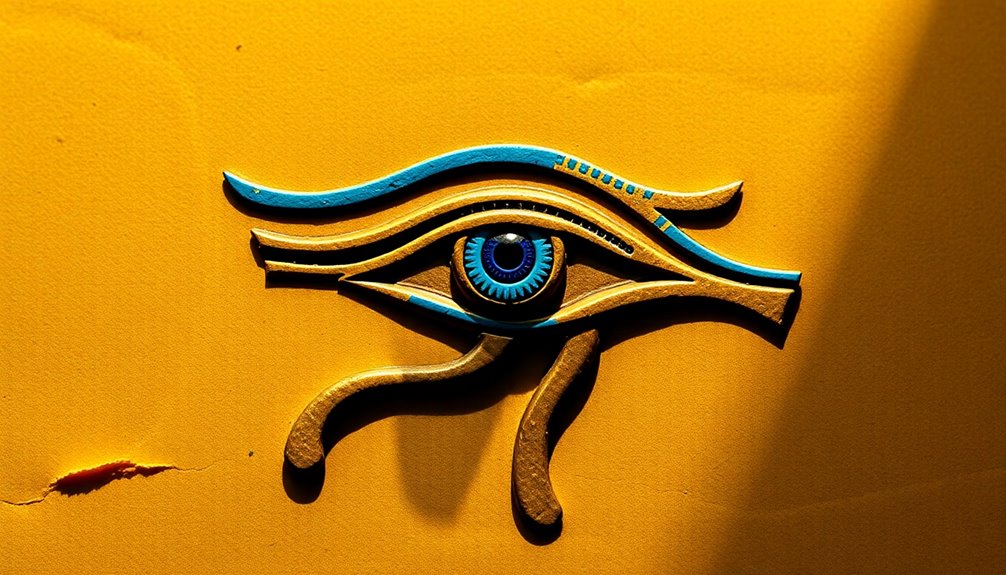
When you explore the Eye of Horus, you'll uncover its powerful symbolism of healing and protection.
The myth of Horus's eye restoration highlights themes of recovery, while the healing powers of Thoth further emphasize its significance.
Amulets featuring this eye not only offer safety in life but also support spiritual well-being in the afterlife.
Horus's Eye Restoration Myth
Often depicted as a symbol of healing and restoration, the Eye of Horus carries deep significance in ancient Egyptian mythology. This powerful emblem originates from the myth where Horus loses his eye in a fierce battle against Set. The eye's eventual restoration, attributed to the god Thoth or the goddess Hathor, embodies themes of life and renewal, highlighting the cyclical nature of existence.
Each component of the Eye of Horus correlates with different senses, reinforcing the idea of wholeness and completeness following loss. Its fractional representations, such as 1/2 or 1/4, symbolize a journey towards restoration and healing.
As you explore this symbol, you'll find that it served as a protective amulet, believed to ward off evil and promote health for those who wore it.
The restoration of Horus's eye also parallels the phases of the moon, symbolizing regeneration and the balance between destruction and healing. This integration of myth and symbolism demonstrates how deeply the concepts of restoration and protection were woven into daily Egyptian life and spirituality, making the Eye of Horus a profound emblem of hope and resilience.
Healing Powers of Thoth
The healing powers of Thoth, the ancient Egyptian god of wisdom and writing, are deeply intertwined with the symbolism of restoration and knowledge. In the myth of Horus, Thoth plays a vital role in restoring the Eye of Horus, which symbolizes healing and protection. When Horus lost his eye in battle with Set, it was Thoth who mended it, reinforcing the connection between healing and understanding.
The Eye of Horus is divided into six parts, each representing a fraction, which highlights not just its mathematical significance but also its symbolic link to completeness and health. This symbolism reflects the belief that true healing encompasses both physical restoration and mental clarity.
Ancient Egyptians widely used amulets bearing the Eye of Horus, believing they offered protective and healing properties. By wearing these symbols, individuals sought aid in recovering from illness and misfortune.
Even today, the Eye of Horus remains a powerful emblem of healing and protection across various cultures. By embracing these symbols, you tap into a legacy that connects wisdom, restoration, and the profound healing powers attributed to Thoth.
Amulets for Protection
Embodying a rich history of symbolism, amulets featuring the Eye of Horus served as powerful tools for protection in ancient Egyptian culture.
You'd find these amulets worn by individuals to ward off evil spirits and guarantee safety throughout their lives and in the afterlife. The Eye of Horus represents healing and restoration, stemming from the myth where Horus lost his eye during battle, only to have it restored by the goddess Hathor.
In ancient Egyptian culture, these amulets were often inscribed on tombs and sarcophagi to provide protection for the deceased, aiding their journey into the afterlife.
Crafted from materials like gold, stone, and clay, they enhanced the protective properties of the Eye of Horus, making them significant artifacts.
Beyond protection, the Eye of Horus also played a role in medicine, symbolizing healing practices and invoking divine assistance to cure ailments.
Mathematical Significance of the Eye
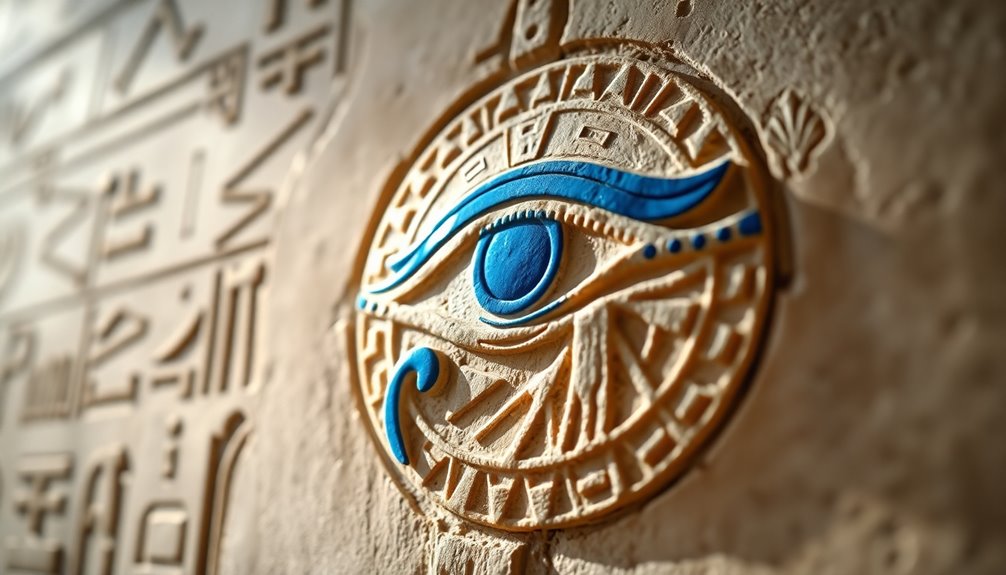
Ancient Egyptians viewed the Eye of Horus not just as a symbol of protection but also as a fascinating mathematical construct. This iconic eye served as a mathematical tool, embodying a unique system of fractions. Each of its six parts represents a different fraction: the right side symbolizes 1/2, the pupil represents 1/4, while the remaining components correspond to 1/8, 1/16, 1/32, and 1/64.
When you sum these fractions, they total 63/64, which signifies completeness and reflects the ancient Egyptians' understanding of imperfection. The missing part alludes to the magical powers of Thoth, the god of wisdom.
Beyond its protective qualities, the Eye of Horus played an essential role in calculations, helping scribes and mathematicians navigate their complex numerical tasks. Each segment of the Eye has also been interpreted to relate to the five senses, illustrating the deep connection between perception and the divine.
The intricate design of the Eye of Horus highlights the intersection of art, mathematics, and spirituality, showcasing the advanced geometric knowledge and symbolism that the ancient Egyptians possessed.
The Parts of the Eye Explained
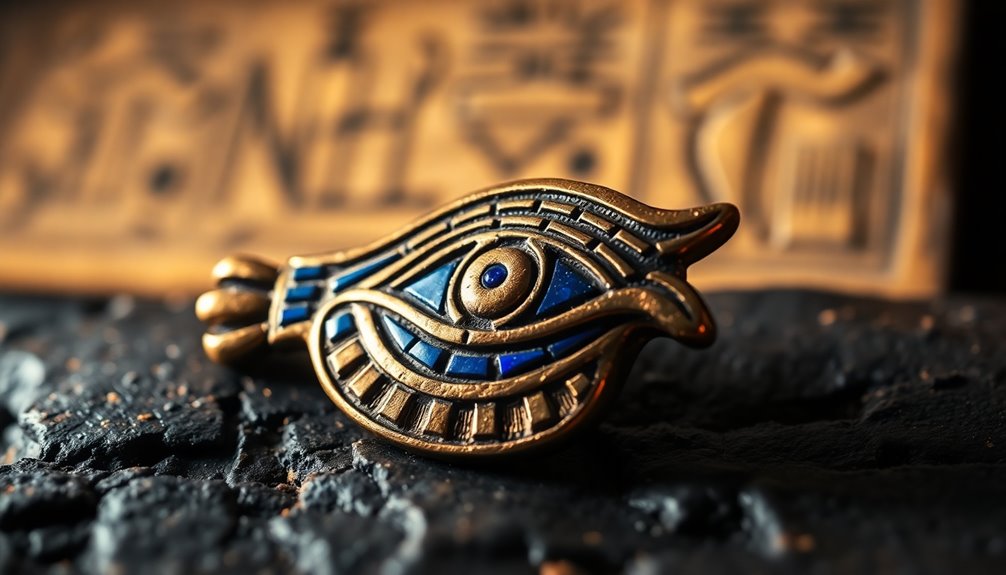
In exploring the Eye of Horus, you'll uncover its six distinct parts, each with unique symbolic meanings.
These elements not only reflect various senses but also highlight their cultural significance in ancient Egyptian life.
Understanding how each part functions can deepen your appreciation of this powerful symbol.
Symbolic Meanings Explained
The Eye of Horus captivates with its intricate design, each part holding significant symbolic meaning. Ancient Egyptians believed this powerful symbol served not just as protection but also as a representation of the senses. The six distinct components of the Eye convey profound insights into their culture:
- The right side symbolizes smell.
- The pupil signifies sight.
- The teardrop represents touch.
Each section of the Eye of Horus also corresponds to fractions that total 63/64, symbolizing imperfection and the magical powers of Thoth, the god of wisdom.
These protective powers were essential in ancient Egyptian life, as the Eye functioned as an amulet believed to ward off evil spirits and misfortune while promoting health and restoration.
In addition to its role as a magical symbol, the Eye of Horus was utilized in hieroglyphics to represent various fractions, highlighting its dual significance as both a divine protector and a mathematical tool.
This multifaceted symbolism makes the Eye of Horus one of the most enduring and recognizable symbols of ancient Egypt, capturing the complexities of their beliefs and practices.
Cultural Significance Discussed
Exploring the Eye of Horus reveals a rich tapestry of cultural significance that extends far beyond its striking appearance. This ancient Egyptian symbol, also known as Wadjet, embodies protection and healing, deeply intertwined with deities like Horus and Thoth.
Each part of the Eye of Horus represents one of the five senses and a fraction, illustrating the concept of imperfection—together totaling 63/64. This symbolism reflects not only the human experience but also the belief in resilience, seen in Horus's recovery after losing his eye to Set.
The Eye's protective properties were integral to ancient Egyptian life; amulets featuring the Eye of Horus were commonly worn to ward off evil and guarantee good health. This powerful symbolism was rooted in the themes of sacrifice and renewal, as Horus's eye was ultimately restored, signifying the cyclical nature of life.
Today, the Eye of Horus has transcended its ancient origins, continuing to resonate as a symbol of protection and spiritual significance in modern cultures. Its enduring legacy showcases the profound impact of ancient Egyptian beliefs on contemporary society.
Parts and Their Functions
Representing a blend of senses and fractions, the Eye of Horus comprises six distinct parts, each with its own unique function. This ancient symbol offers a fascinating insight into human experience, linking perception to the senses.
Here's a breakdown of its parts:
- Right Side: Represents smell (1/2)
- Pupil: Symbolizes sight (1/4)
- Eyebrow: Signifies thought (1/8)
- Left Side: Correlates with hearing (1/16)
- Teardrop: Indicates touch (1/32)
Together, these parts total 63/64, reflecting imperfection, while the missing fraction represents the magical powers of Thoth.
The teardrop, often seen as a symbol of touch, connects physical interaction with emotional expression, emphasizing how ancient Egyptians viewed the interconnectedness of senses and perception.
Beyond its rich symbolism, the Eye of Horus served as a protective emblem, safeguarding individuals from harm. Its intricate design not only illustrates spiritual beliefs but also showcases the practical applications of mathematics in daily life.
Understanding these parts deepens your appreciation for the Eye of Horus and its profound significance in ancient Egyptian culture.
Modern Uses of the Egyptian Eye
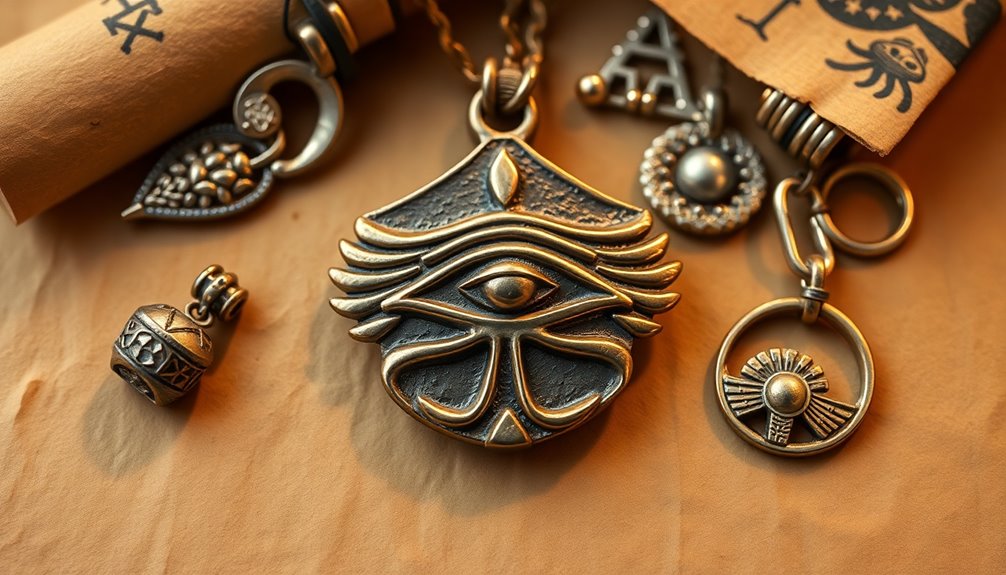
In today's world, the Eye of Horus has found a vibrant place in various cultures and practices. You'll often see the Egyptian Eye of Horus painted on fishing vessels in Mediterranean regions, where fishermen believe it brings protection against bad luck and misfortune.
This ancient symbol has transcended time, becoming a popular amulet and jewelry piece, thought to safeguard the wearer from negativity and ill fortune.
The Eye of Horus also enjoys a significant presence in modern art, frequently appearing in tattoos and decorative items. Here, its symbolism emphasizes protection and divine insight.
Additionally, it resonates deeply within spiritual and wellness communities, where it represents healing and restoration.
Interestingly, the Eye of Horus maintains relevance among occultists and conspiracy theorists, often associated with power and hidden knowledge.
Whether you're drawn to its protective qualities, its artistic appeal, or its spiritual significance, the Egyptian Eye of Horus continues to captivate and inspire.
You might find its allure in various aspects of life, reflecting a blend of ancient wisdom and contemporary relevance.
The All-Seeing Eye Explained
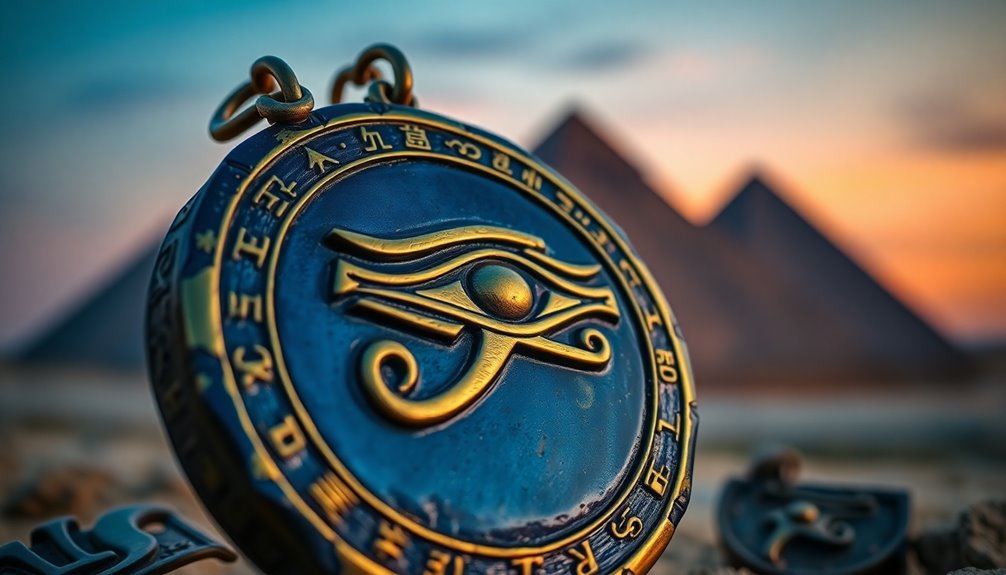
Throughout history, the All-Seeing Eye has captivated minds with its powerful symbolism. This emblem, often linked to the Eye of Horus and the Eye of Ra, represents various aspects of ancient Egyptian culture, including divine protection, authority, and health.
It serves as a reminder of the gods' watchful gaze over humanity, emphasizing the balance between order and chaos.
Here are three key meanings behind the All-Seeing Eye:
- Eye of Horus: Symbolizes healing and restoration, tied to the myth of Horus losing his eye in battle, only to have it restored by the goddess Hathor.
- Eye of Ra: Represents destruction and punishment, dispatched by the sun god Ra to maintain cosmic order and guard against evil.
- Duality of Nature: Together, these symbols illustrate the complex interplay of protection and authority within Egyptian mythology.
The All-Seeing Eye reflects the rich mythology of ancient Egypt, reminding you of the significance placed on maintaining harmony and the gods' ever-watchful presence.
Understanding its meanings can deepen your appreciation for this enduring symbol and its impact on culture and history.
Eye of Ra vs. Eye of Horus
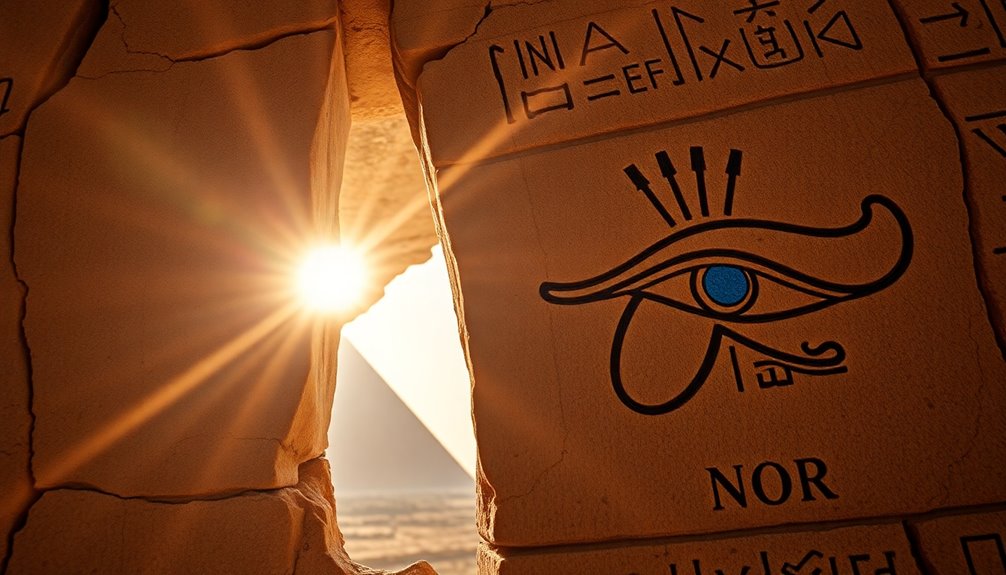
The All-Seeing Eye encompasses two powerful symbols: the Eye of Ra and the Eye of Horus, each with its own significant meanings and associations. The Eye of Ra, linked to the sun god Ra, symbolizes power and authority. It's often depicted as a fierce force, capable of punishing humanity. In contrast, the Eye of Horus is associated with healing and protection, embodying restoration after Horus's battle with Set.
Here's a comparison of these two ancient Egyptian symbols:
| Symbol | Association | Meaning |
|---|---|---|
| Eye of Ra | Sun God | Power and destruction |
| Eye of Horus | Moon and healing | Restoration and balance |
| Both | Protection | Duality of creation and destruction |
While the Eye of Ra represents the intensity and fury of the sun, the Eye of Horus signifies the nurturing aspect of the moon. Together, they illustrate the balance between creation and destruction in ancient Egyptian mythology, providing insight into the dual nature of divine intervention. Understanding these symbols deepens your appreciation for their rich history and significance.
Cultural Impact in Art

Ancient Egyptian art vividly showcases the cultural impact of symbols like the Eye of Horus and the Eye of Ra, both of which played crucial roles in society. The Eye of Horus is particularly significant, symbolizing protection and royal authority. You'll often find it depicted on tomb walls and artifacts, meant to ward off evil in the afterlife.
Artists integrated the Eye of Horus into various forms of art, reflecting its importance in daily life and spiritual beliefs. This influence can be seen in:
- Jewelry and decorative pieces, where amulets were believed to provide safety and healing.
- Hieroglyphs that served a dual purpose, showcasing divine oversight while aiding mathematical calculations.
- The distinctive shape of the Eye, representing the interconnectedness of perception and divinity.
Additionally, the Eye of Ra complements the Eye of Horus, emphasizing themes of balance and the duality of protection and destruction.
Together, these symbols underscore the profound cultural impact of ancient Egyptian art, illustrating how they shaped beliefs about life, death, and the divine.
Myths Surrounding the Egyptian Eye

Myths surrounding the Egyptian Eye are rich with symbolism and narrative depth. The Eye of Horus, originally known as Wadjet, stands as a powerful emblem of protection, healing, and restoration. This eye symbolizes Horus's struggle against his uncle Set, during which he lost one eye. Different versions of this mythology highlight the themes of duality and rebirth, often crediting Thoth or Hathor with its miraculous healing.
In contrast, the Eye of Ra embodies destruction and punishment, illustrating the complexity of divine power in ancient Egyptian mythology. While the Eye of Horus is associated with the moon and healing, the Eye of Ra links to the sun and retribution, showcasing a cosmic balance between these forces.
Throughout ancient Egypt, the Eye of Horus served as a protective amulet, believed to ward off evil spirits and guarantee safe passage through the afterlife.
This belief in its power illustrates how deeply the myths surrounding the Eye of Horus permeated their culture, providing not just protection, but also a sense of hope and restoration in the face of adversity.
Frequently Asked Questions
What Does the Egyptian Eye Symbolize?
The Egyptian Eye symbolizes protection, health, and restoration.
You'll notice it's often linked to the god Horus, representing divine authority. The eye comprises six parts, each signifying different senses, showcasing its symbolic depth.
The right eye connects to the sun and power, while the left eye relates to the moon, emphasizing healing.
Often found in amulets and jewelry, it's believed to guard against evil spirits and misfortune, both in life and the afterlife.
Why Is the Eye so Important in Egypt?
The Eye holds immense importance in Egypt because it symbolizes protection, health, and restoration.
You'll find it often used in jewelry and amulets, designed to ward off evil and provide divine safety.
Its presence in tombs and temples underscores its role in ensuring a safe journey to the afterlife.
What Is the Bad Meaning of the Eye of Horus?
The Eye of Horus can symbolize more than just protection; it also carries darker meanings.
When you explore its history, you might see it representing conflict and vulnerability. The eye's loss during Horus's battle with Set reflects betrayal and suffering, reminding you that even powerful beings face destruction.
Additionally, its necessity to ward off evil suggests the presence of malevolent forces, adding a layer of fear to its protective connotation.
What Does the Bible Say About the Eye of Horus?
The Bible doesn't specifically mention the Eye of Horus, but it critiques idolatry and false gods, which could apply to its symbolism.
You'll find themes of protection and divine oversight in verses like Psalm 121:5-6 and Proverbs 15:3.
While the Eye embodies balance, which parallels biblical concepts, its use in various cultures raises concerns about paganism, as noted in Exodus 20:4-5.
It's crucial to reflect on these contrasts when exploring its meanings.
Conclusion
In summary, the Egyptian Eye is far more than just an ancient symbol; it's a powerful emblem rich with history, healing, and mystique. By understanding its origins and meanings, you reveal a treasure trove of cultural significance that's shaped art and mythology for centuries. Whether it's the protective gaze of Horus or the all-seeing wisdom of Ra, the Eye's impact is nothing short of monumental, echoing through time like a thousand whispers of the past.


